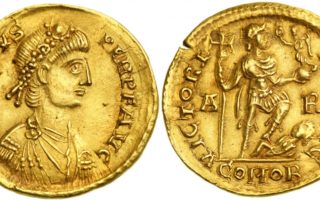Hi to all of you ! How are you ? Today we are not going to talk about a Roman dynasty like the previous weeks but about a period of the Roman Empire. It is called “the Military Anarchy”. We will see the continuation of Roman history with that time. We will therefore see in this article, of whom “the Military Anarchy” was made up, when did it exist…. Now let’s get to the heart of the matter and, above all, enjoy your reading.
Context of the Military Anarchy
This anarchy began following the end of the Severan dynasty, with the death of Severus Alexander. It lasted from 235 to 268 AD and was a period of unrest for the Romans. Indeed, during this period, the army more or less rules the Empire, electing who it wants and when it wants. Economic, social and cultural crises appear, famines and epidemics affect the cities, the Empire is fragmented … (What a mess!). Also, during this anarchy, the “Thirty Tyrants” series (we’ll see what it is about a little later in this article) happens. In short, this is a dark period for the Roman Empire which will have a hard time recovering and which, moreover, will bear the consequences for life.
Who did the Military Anarchy consist of?
This period, in terms of the emperor, saw quite a few pass in a short time. Indeed, it has more than fifteen, including: Maximin Ier Thrace (March 235 AD – June 238 AD), Gordian I (March 238 AD – April 238 AD), Gordian II (March 238 AD) JC – April 238 AD), Balbin (April 238 AD – July 238 AD), Pupien (April 238 AD – July 238 AD), Gordian III (May 238 AD – April 244 AD), Philippe I the Arab (February 244 AD – September 249 AD), Philip II (April 247 AD – September 249 AD), Trajan Decius (September 249 AD – June 251 AD), Hérennius Etruscus (May 251 AD) – June 251 AD), Hostilien (May 251 AD – October 251 AD), Trébonien Galle (June 251 AD – August 253 AD), Volusien (October 251 AD – August 253 AD), Emilien (April 253 AD – August 253 AD), Valérien (July 253 AD – June 260 AD) and Gallien (October 253 AD – September 268 AD).
Now that we know who ruled then, let’s see the unfolding of Military Anarchy, but before that, what is the “Thirty Tyrants” series?
The Thirty Tyrants
The “Thirty Tyrants” is a period which saw a succession of different usurpers. A usurper is a person who takes power (he usurps power). This series took place during the Military Anarchy and currently only a little less than twenty usurpers are really known, the rest having either never existed or we have no trace. As to the facts of this period, many sources are uncertain.
The History of Military Anarchy
This anarchy began with the reign of Maximin I the Thrace. The latter began his reign with a campaign in Germany, which he won and won over the Sarmatians. Thus, he devoted himself strongly to the army but little to the towns and the people. Indeed, he will never set foot in Rome. In addition, it overtaxes the inhabitants thus raising their anger. Towards the end of his reign, in 238 AD, Gordian I and Gordian II were appointed emperors in Thrace. Also, in April, the co-emperors Balbin and Pupien are appointed emperors by the Senate in Rome. Maximin I the Thrace, dies assassinated by his soldiers, during a siege in Aquileia.
Around the same time, the reigns of Gordian I and Gordian II took place. The latter only reigned for about a month. First, Gordian I was appointed emperor, but unwillingly. In the process and because of his advanced age (over 80 years), he named his son Gordien II. The latter, in a battle against the Third Legion, led by Capellianus (a supporter of Maximin I), died in action. Learning of the death of his son, Gordian I committed suicide and thus ended the reigns of Gordian I and Gordian II.
Following the death of the two Gordians and Maximin, two new co-emperors will be placed on the throne. These are Balbin and Pupien. During their reign, Balbin took charge of ruling Rome while Pupian took charge of the army. But due to their unpopularity, they are forced to adopt a successor who will become Gordian III. Subsequently, the two co-emperors are killed by the Praetorian Guard.
Then will take place one of the longest reigns of Military Anarchy: that of Gordian III. It lasted almost 6 years. His reign began in his thirteenth year. At first, being too young to reign, he was helped by his parents as well as senators. He subsequently experienced numerous revolts across the Empire. Also, in AD 241, at the age of 16, he married. Then he fought various battles and died in one of them at the age of 19.
Philip I the Arab, reigned after Gordian III. During his reign, of a duration similar to that of Gordian III: about 6 years, he was benevolent towards Christians and would have even converted to Christianity which would make him the first Christian Roman emperor but, he did also, among other things, a successful campaign against Quades and Carps. He died in combat, in battle with the troops of Decius. Also in 247 AD, Philippe I made his son Philippe II “August”. The latter will be killed two years later in 249 AD.
Trajan Decius therefore took over. During his reign, he campaigned against the Goths who were then beginning to invade the Empire. Also, he faces an epidemic of plague which will weaken the Romans. In addition, he will persecute Christians in the year 250 AD. Finally, he will return to the front against the Goths where his son Hérennius Etruscus, then emperors for a month and him, will be killed.
The successor was Trébonien Galle. The latter began his reign by appointing Hostilien co-emperor. But the latter died a few months later. Then, Trebonien Galle named his son, Volusien new co-emperor. During their reign, the latter two will face the plague present in Rome and may be responsible for the death of Hostilian. They will also fight the Goths and the Persians. They will be assassinated in 253 AD by their troops. The latter being afraid of Emilien.
Emilien was appointed emperor by the Senate but will be quickly assassinated by his troops. The latter, siding with Valérien I.
Valérien I therefore took over. His reign began in AD 253, at the age of almost 60, with a long defense of the Empire’s borders. This period lasted from 253 to 257 AD and during it, Valérien I was accompanied by his son who will be the next emperor: Gallien.
Following this time, the emperor began a wave of persecution against Christians. This lasted from 257 to 259 AD. It has resulted in numerous seizures of Christian property, numerous death sentences and various prohibitions on worship and obligations under the risk of the death penalty. Valérien dies in 260 AD, captured by the Persians. The causes of his death are unknown. He will be succeeded by Gallien.
Gallienus was therefore the last emperor to reign in Military Anarchy. His reign was the longest, with around 15 years in power. He began his reign by stopping the persecutions put in place by his father against Christians. As for the rest of his reign, he will have mainly tried to unite an Empire divided following many revolts that took place in different regions. He died in 268 AD, assassinated in Mediolanum, current city of Milan and will be succeeded by Claude II the Gothic.
Summary
The Military Anarchy was therefore a very dark period for the Roman Empire and was very devastating for it. Besides, he will keep the stigma until the end. This period was therefore characterized by a rapid succession of emperors, most of whom reigned only for a few months. But above all the latter were mostly chosen thoughtlessly without long-term thought and often placed on an ejection seat, getting killed at the slightest mistake. So there were many blunders committed during the Military Anarchy leading to a period of misfortune.
This article is now complete. Hope you enjoyed it, if so please let me know in the comments space and also tell me what topic you would like me to talk about in a future post. In fact, for the next article, we will continue to talk about Roman history with “the Illyrian emperors”. See you next week!
Receive my free book Around the Roman Coin by clicking here




